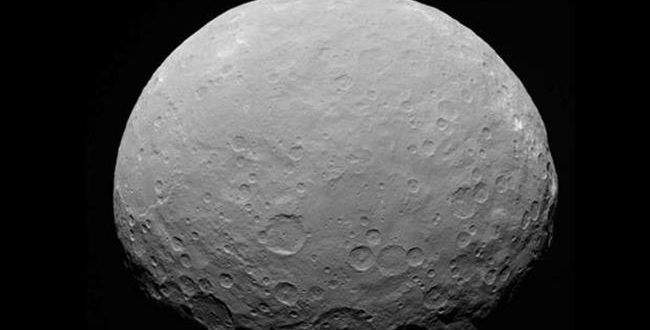Researchers say they have found organic compounds on the dwarf planet Ceres, boosting the tiny world’s attractiveness in the hunt for extraterrestrial life.
A study, published in Science by planetary scientists in Italy and the US, “opens the possibility that primitive life could have developed on Ceres itself”, writes the European Space Agency’s Michael Kueppers in an accompanying Perspectives piece.
Scientists have been treated to a ringside view of Ceres, the largest body in the asteroid belt, since the Dawn probe slotted into its orbit in March 2015.
The spacecraft’s slew of instruments has uncovered a number of clues – and thrown up many questions – about the planet’s composition and evolution. For instance, bright white spots on its surface are likely to be salts left behind when ice sublimated – but, if so, it means Ceres formed far from its current orbit. (Exactly where remains a mystery.)
What makes the dwarf so interesting to astrobiologists, though, is its chemistry. Probe observations already pointed to a world abundant in water ice, salts, carbonates and clay minerals – but until now it was unclear whether it also contained the carbon-based molecules thought crucial in the development of life.
To search for these molecules, Maria Christina De Sanctis from the Italian National Institute for Astrophysics and her crew used the Visible and InfraRed Mapping Spectrometer on board Dawn to observe a 1,000-square-kilometre region around a feature named the Ernutet crater.
They found patches that absorbed light of particular wavelengths – a signature of organic molecules – scattered around and over the area.
While the data can’t establish exactly what the compounds are, they match the wavelength absorption characteristics of tar-like asphaltite and ketite.
So did these molecules hitch a ride on another object? Ceres is thought to have formed along with the rest of the solar system some 4.5 billion years ago – giving it plenty of time to collide with comets and asteroids laden with organic molecules and retain scraps of their chemical make-up.
That’s probably not the case, the researchers write. An asteroid or comet smashing into the dwarf planet would generate so much heat that the vast majority of organics would be lost. Nor was the pattern of patches expected if they’d been ferried on another object.
So while it’s not impossible that the compounds survived a collision, it is considered highly unlikely.
A more plausible scenario is hydrothermal processing. While Ceres looks like a cold, dead rock, it may have retained heat from its formation – and perhaps a subsurface ocean. Clay minerals can catalyse organic compound synthesis.
Through hydrothermal reactions, the team writes, “we expect that Ceres is a perfect world to develop substantial indigenous organic material”.
Agencies/Canadajournal
 Canada Journal – News of the World Articles and videos to bring you the biggest Canadian news stories from across the country every day
Canada Journal – News of the World Articles and videos to bring you the biggest Canadian news stories from across the country every day



